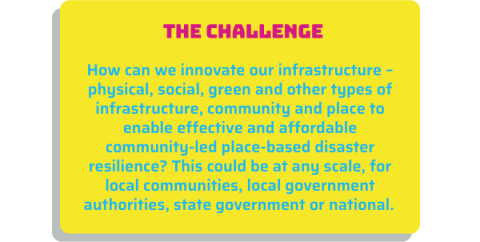


Flex your creative thinking muscles and help revolutionise disaster resilience across Australia.
We’re looking for teams of the best and brightest early career researchers, postgraduate and undergraduate students from across Australia to innovate the way we respond to bushfires, floods, storms, cyclones and other natural hazards.
If this sounds like you, the Disaster Challenge and Australia’s emergency management sector want to hear from you. (no prior disaster experience or knowledge needed!)
With a national final and prizes, what can you and your team bring that is new, exciting, bold and will make a real difference in the lives of Australian communities?
Entries close 5:00pm AEST, 15 June 2025
Questions, ideas, queries? Register for this year’s online briefing, 12:00-1:00pm AEST, 15 May 2025 to hear from the organisers and past participants to make your submission stand out from the crowd.

Infrastructure (/ˈɪnfrəˌstrʌktʃə/), noun “the basic physical and organizational structures and facilities needed for the operation of a society.” Oxford Dictionary
We recently witnessed the impacts of disasters at-scale in Australia and overseas. From cities to remote communities, it is imperative to plan ahead – to be ahead of ready.
As communities confront repeated and increasingly severe multi-hazard and multi-consequence natural hazards, a key but challenging priority is to ensure reliable infrastructure of all kinds – physical, social, green, and other types of infrastructure.
Conventionally, infrastructure has meant physical infrastructure focused largely on physical assets, including roads, rail, energy transmission, while more recently, social and community infrastructure has emerged to encompass ways communities can be supported to support themselves during disasters, which includes places, services, programs and initiatives that improve liveability, physical and mental health. Green infrastructure is a new way of speaking about using nature to protect and mitigate the effects of natural hazards.
The time, money and resources needed to conceptualise, design, construct and implement infrastructure is significant. While the time and cost of physical infrastructure such as a road, bridge or powerline is well understood, other types of infrastructure, including green and social infrastructure options may be unprecedented or not well understood.
How do you think we can innovate our infrastructure – physical, social, green and other types of infrastructure, community and place to enable effective and affordable community-led place-based disaster resilience?
The Disaster Challenge will take place in three phases:
Why enter the Disaster Challenge?
As an early career researcher, postgraduate or undergraduate student, this is a great opportunity to use your ideas to help change how we manage natural hazards. The judges are involved in day-to-day management of natural hazards around Australia and your ideas will help them work with communities to improve preparedness and resilience, save lives, protect property, keep people safe and recover better after disasters. Pitching your concept puts you in the running for a $5,000 cash prize and the opportunity to progress your idea further. This is an excellent opportunity to boost your credentials and advance your career, with extensive promotion of the winning concept. For more information on eligibility, how to enter and other details visit disasterchallenge.com.au. Read and review the Guide for Entrants, available now on the website, for handy tips on how to get started.
Want to be inspired by previous Disaster Challenges? See, read and watch more about the 2022, 2023 and 2024 Disaster Challenges.